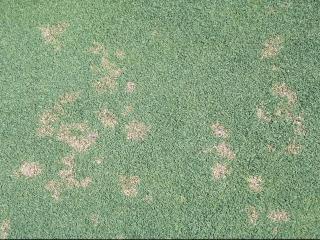Dollar spot
Cause and symptoms
A fungal disease causes dollar spot, particularly in Queensland blue couch or saltene lawns, both of which have quite high watering needs. The disease can develop rapidly in humid weather, and is most prevalent from November to March. Soils deficient in nitrogen favour the development of the fungus.
Although each individual brown spot rarely exceeds the size of a 50 cent piece (or a US dollar, hence the common name), often the spots can merge to create larger patches, and the fungus bites deeply into the mat of turf. The markings on the grass blades are tan coloured with a brown border. Another feature of the disease is fine webbing, which may be seen early in the morning when the lawn is covered in dew.
Treatment
Fungicide is best used as a preventative rather than as a cure. Sometimes fungicides need to be alternated because the fungus can develop resistance to the chemicals in the first product used. Home garden fungicides include mancozeb with sulphur, chlorothalon, iprodione and tebuconazole with trifloxystrobin.
Prevention also relies on other factors such as thatch control, moderate fertilising and watering in the morning so the grass dries out during the day.
Control is time consuming and it may be easier to replant with grasses more suited to Western Australian conditions.

